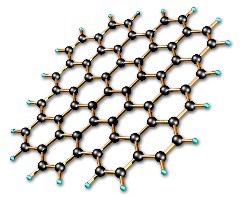Physicists and engineers from the universities of Manchester and Cambridge in the U.K. have devised a method for improving graphene devices as photodetectors in future high-speed optical communications. Their findings appear in the 30 August issue of the journal Nature Communications (paid subscription required).
Graphene is a two-dimensional layer of carbon atoms arranged in a hexagonal lattice that has a large number of unique electrical and physical properties making it a desirable material for many new technologies. The team on this project includes Manchester professors Andre Geim and Kostya Novoselov who discovered graphene and won the 2010 Nobel Prize in physics.
The researchers combined graphene with metallic nanostructures that increased its ability to harvest light by 20 times. These plasmonic nanostructures, as they are called, enhance the optical electric field felt by graphene and concentrate light in its one-atom-thick carbon layer.
Previous research revealed that graphene can create a simple solar energy cell that generates electric power by adding two closely-spaced metallic wires on top of the graphene and shining light on this structure. And because of the unique nature of the electrons in graphene, such devices can be tens and potentially hundred times faster than communication rates in the fastest internet cables.
The problem in translating these properties of graphene into practical applications has so far been the material’s low efficiency. Graphene absorbs little light — only about three percent — with the rest escaping without generating power.
The Manchester/Cambridge discovery of plasmonic nanostructures boosts the light-harvesting performance of graphene by 20 times, without sacrificing any of its speed. “Many leading electronics companies consider graphene for the next generation of devices,” says Kostya Novoselov. “This work certainly boosts graphene’s chances even further.”
Read more: Lab Creates Graphene Composite for Lithium Ion Batteries
* * *


 RSS - Posts
RSS - Posts
[…] Read more: Nanotech-Enhanced Graphene Can Propel Optical Communications […]